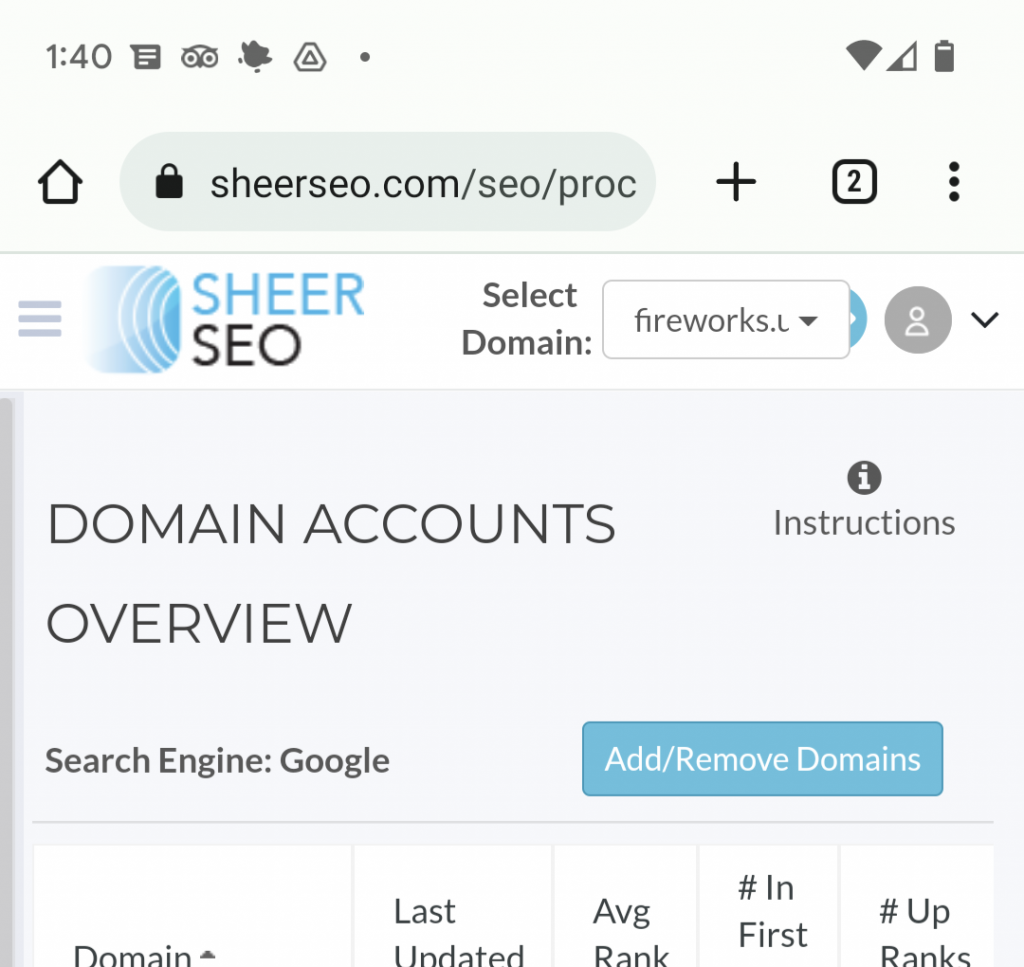Beyond Basic SEO—Powerful Google Features Improve Organic Search Results
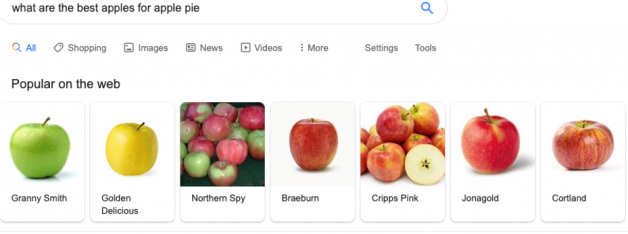
SEO and Google are like soup and salad—you can’t have one without the other. But are you making the most of what Google has to offer to boost your rankings? Let’s look beyond the basic social media strategy to see how some powerful Google options can help put you on top.
Focus on Featured Snippets
That box of text that appears above regular SERPs (Search Engine Results Pages) is the featured snippet; it can contain short answers, lists or tables generally less than 29 words long. Although Google introduced featured snippets back in 2014, many marketers fail to take full advantage of them.
The featured snippet appears below any Google Ads and directly above all other organic results. This is prime real estate, as it provides information considered key to the search query without needing to click around various websites to find it.
For example, when you search for “featured snippets 2019”:
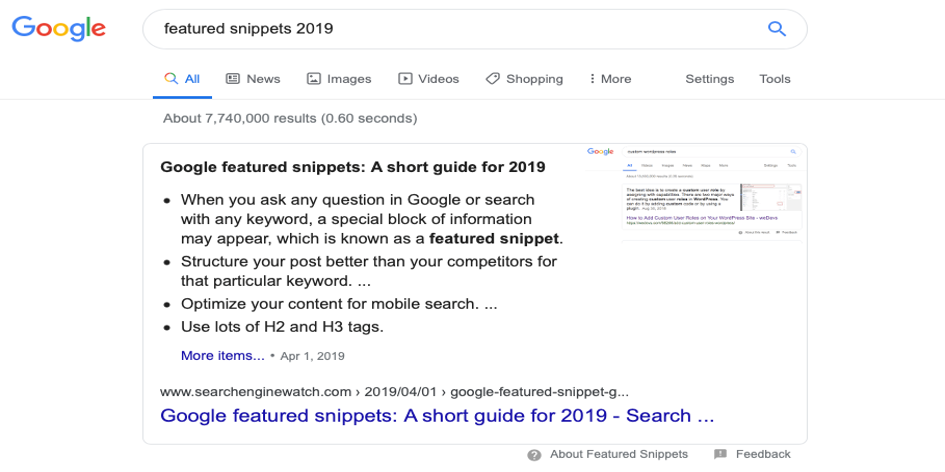
Note the link to a particular page that appears before all the other results. Since it appears above the first organic results, it’s sometimes called “position 0.” That position is where users are most likely to click on first. That’s where you want to be.
How does Google determine what goes in a featured snippet?
Obviously, if you want to be the featured snippet, you have to figure out how Google determines what winds up there. But as you might expect, Google isn’t totally transparent about this, beyond saying, “Content on the web is always changing…so our results on any given query can change…We strive to update our systems to keep our results relevant and useful.”
The mystery behind what Google does to elevate listings to the feature snipped position is of late a bit of controversy, stemmed in part by what SEO professional Lily Ray terms the Featured Snippet-apocalypse regarding Google core algorithm updates in January 2020. At this point, it’s debatable whether this is a good or bad thing, or how it will change SEO practices, particularly as it relates to featured snippet.
Perhaps the best advice is to review and test your own data and see if your organic Google search is declining or growing. Then you may want to tweak your listing to see how you might optimise it for better results. Which is good practice in any event, regardless of the current hubbub.
Since only Google determines whether a page becomes a featured snippet, how could you possibly game the algorithm gods to get your site on one? Educated guessing is a good start. Here are a few things you can do on your page that is likely to increase your chances of landing in a featured snippet:
- Add some questions. Featured snippets like to display questions. Add the question to the H-tags and write an answer. Typical questions should address “What is” and How to.”
- Add Schema.org markup. Schema code identifies different elements on your page so Google gets a better idea of your content and page structure. For example, the markup itemtype identifies whether content refers to, say, a book or software, while itemprop points to its features, say a thriller or accounting tool. The more Google knows about your site, the greater the likelihood it gets plugged into the search algorithm.
- Include Bullet Points, Lists and Tables. Featured snippets frequently display bullet points, lists and tables as a way to best summarise information. So if your website includes bullet points, lists and tables, the more likely it is that Google will pull them into a featured snippet.
- Get ranked on the first page. You don’t get a chance to be a featured snippet if you aren’t landing on the first page results. You don’t need to be first, but you need to be somewhere on that page. So if your site isn’t on the first page in the first place, you need to do some basic SEO to get back there before you even think about optimising for a featured snippet. Things you should be doing anyway include making your site mobile-friendly, easy to navigate and readable, with high-quality optimised images.
Important Note: Google no longer repeats a listing in the overall search results if it appears in the featured snippet. The rationale is this “declutters” search results by eliminating repetition so users can find relevant information more quickly. In some cases, getting off the main page but into the featured snippet can actually hurt your SEO results. In this event, use the nosnippet tag to tell Google you don’t want to be there.
If it turns out that featured snippets aren’t going to improve your SEO, here are some other similar types of Google snippets to check out.
Get Your News into Top Stories
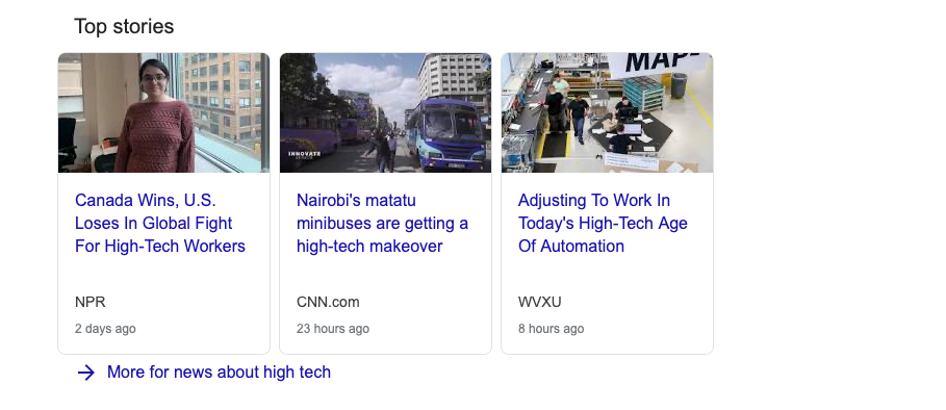
Google’s Top stories is a separate channel displayed on the first position of SERP. But you don’t necessarily have to be CNN to qualify. To appear in Google News, use the Publisher Center tool to share your news content. The more high-quality, current and relevant content you can feed to Google News, the greater the likelihood you’ll get a top story today mention.
Getting Found is a Carousel, My Friend
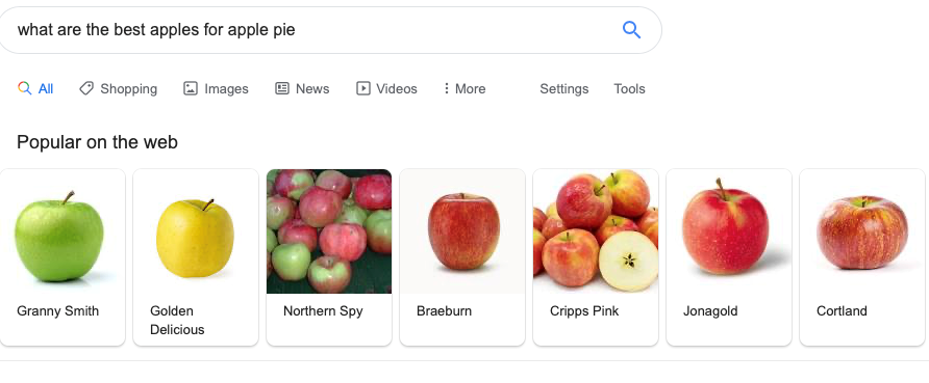
Carousel Results appear at the top of the page in responds to general questions, such as “What are the best…” or “What are the top selling…” Clicking on one of the Carousel results sends the user to a new set of search results, which may include your site. To increase the chances of your site being found in such a Carousel:
- Optimise your GMB (Google My Business) directory. Add important and pertinent information related to your business (such as videos and links), descriptive text about what your business does, and make sure all your contact information is current.
- Use high resolution visuals to represent your brand and draw attention to your products and services.
- Track keywords related to your business that display on Carousel Results.
- Post positive customer reviews and testimonials of your products and services on your website.
Did We Just Mention Reviews?
In addition to publishing testimonials, your clients can rate your website using the star system, with five stars being your goal.

Add a rating form to your site if you want starred reviews to display on your search results. How you get five star reviews is to provide your customers with excellent service. You can ask satisfied customers to provide reviews. Resist the temptation to consider providing your own reviews as “creative advertising”—Google is resolute in rooting out and penalising fake reviews.
Think About the Knowledge Graph
The Knowledge Graph is a block on the right hand side of the page that provides some description related to a query. For example, if you were to search for the author Ernest Hemingway, the Knowledge Graph display a series of images and pertinent information such as his books, quotes and personal history.
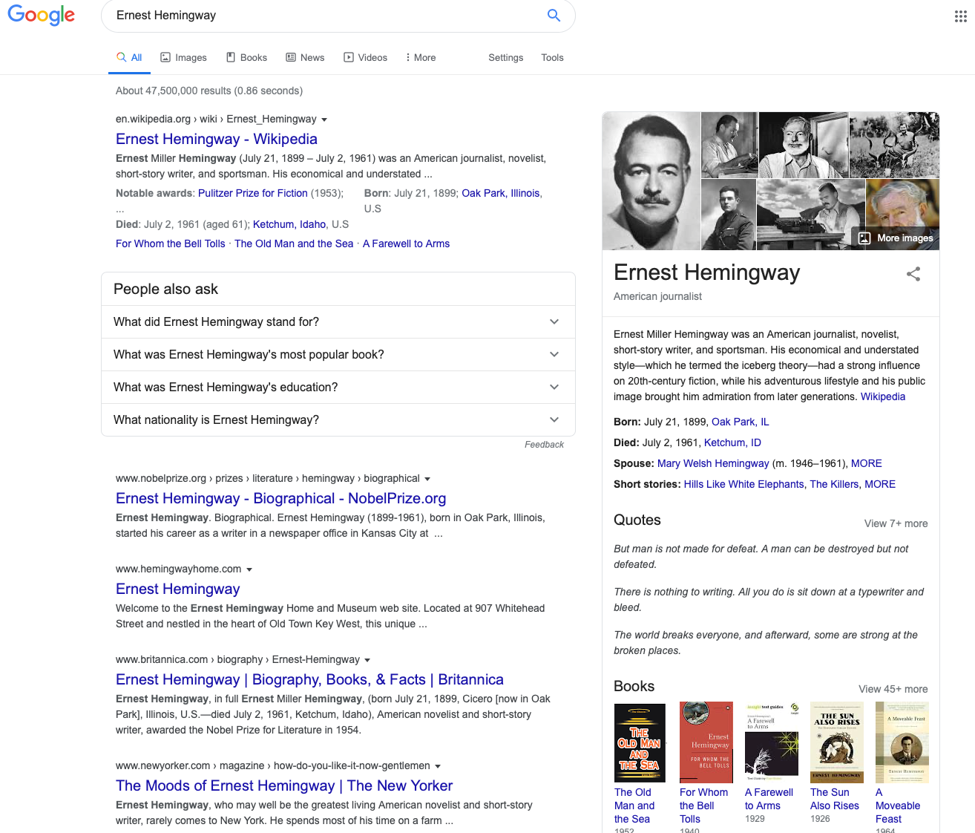
Frequently, the results displayed in the Knowledge Graph are derived from Wikipedia. To maximise your chances of getting on the graph, create a company Wikipedia page. Also, since the Knowledge Graph draws on the display of graphics, optimise all your images for a commercial query.
Create Your Own Knowledge Panel
You can create a Knowledge Graph that represents your business. This is generally called a Knowledge Panel (yes, we know it’s confusing, since the so-called graph is actually a panel, but bear with us). The difference is that for specific kinds of searches (“What auto repair shop is located within five miles of my location?”), Google may look for a GMB account.
To increase the chances that your own Knowledge Panel displays for a relevant search:
- Verify your site with the Google Search Console.
- Add structured data markup for your business and employ an SEO service to output a complete structured data graph for your website pages.
- Ensure all relevant information pertaining to your location, services, contact information and images in GMB are accurate.
- Verify your panel.
A Final Snippet of Advice
Above all, you want to create great content. All these snippets can help searchers find just how great it is.
Author Bio
Richard Nolan is the founder of the digital marketing agency Rife Interactive, specializing in SEO services, promotional videos and dental marketing.


